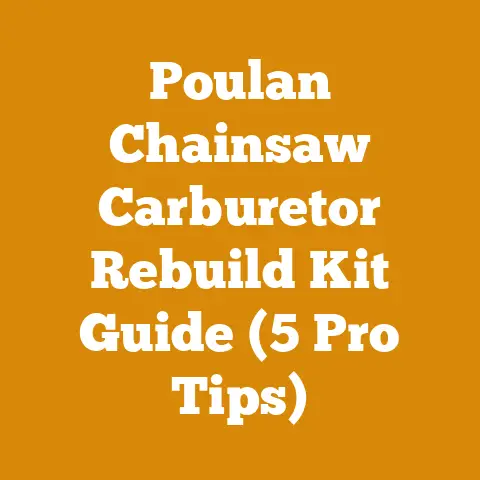Husqvarna 357: Enhancing Saw Performance (5 Expert Mods)
In the heart of a world increasingly focused on sustainability, the allure of wood as a renewable energy source and building material has never been stronger.
From the crackling warmth of a winter fire to the solid foundation of a timber-framed home, wood connects us to nature in profound ways.
However, with this connection comes a responsibility – to manage our forests sustainably, to process wood efficiently, and to utilize every resource wisely.
The global wood processing and firewood industry is a complex landscape, currently valued at hundreds of billions of dollars annually, with significant growth projected in the coming years, fueled by both residential heating needs and the burgeoning bioenergy sector.
Yet, efficiency and sustainability are key to navigating this landscape responsibly.
As an enthusiast myself, I’ve spent years immersed in the world of chainsaws, axes, and wood-splitting mauls.
I’ve felt the satisfaction of transforming a fallen tree into a neatly stacked pile of firewood, ready to warm a home through the coldest months.
I’ve also experienced the frustration of a dull chain, a stubborn log, or a poorly seasoned stack that refuses to burn properly.
Through these experiences, I’ve learned that the right tools, techniques, and a healthy dose of patience are essential for success.
Husqvarna 357: Enhancing Saw Performance (5 Expert Mods)
The Husqvarna 357 is a workhorse.
It’s known for its power, reliability, and ability to handle a wide range of tasks, from felling trees to bucking firewood.
However, even the best tools can be improved.
These five mods are designed to squeeze every last ounce of performance out of your 357, making it a more efficient and enjoyable tool to use.
1. Muffler Modification: Unleash the Beast
The first, and often most impactful, modification is a muffler mod.
The stock muffler on the Husqvarna 357, like many chainsaws, is designed to meet noise regulations and emissions standards.
This often restricts exhaust flow, which in turn limits the engine’s power potential.
A muffler modification involves opening up the muffler to allow for better exhaust flow, resulting in increased horsepower and torque.
Why Modify the Muffler?
- Increased Power: By reducing backpressure, the engine can breathe easier and generate more power.
Many users report a noticeable increase in cutting speed and overall performance after a muffler mod. - Improved Throttle Response: The engine will rev up more quickly and smoothly, making it easier to control and more responsive to your commands.
- Cooler Running: Improved exhaust flow can help to reduce engine temperature, which can extend the life of your saw.
The Process:
Important Safety Note: Before performing any modifications, disconnect the spark plug wire and ensure the saw is cool.
Always wear eye protection and gloves.
- Remove the Muffler: Carefully remove the muffler from the saw.
The exact procedure will depend on your specific model, but typically involves removing a few screws or bolts. - Identify Target Areas: Examine the muffler and identify areas where you can safely and effectively increase exhaust flow.
Common areas include the outlet port and the internal baffles. - Drill or Cut Openings: Using a drill or rotary tool with a cutting wheel, carefully create new openings or enlarge existing ones in the muffler.
Be mindful of the internal components and avoid damaging them.
A good starting point is to add a second outlet port, roughly the same size as the original. - Deburr and Clean: After making the modifications, thoroughly deburr all edges and clean the muffler to remove any metal shavings or debris.
These shavings can damage the engine if they enter the combustion chamber. - Reinstall the Muffler: Carefully reinstall the modified muffler onto the saw.
Ensure that all screws or bolts are securely tightened. - Retune the Carburetor: This is crucial!
A muffler mod will lean out the air/fuel mixture.
You must retune the carburetor to compensate.
Start by adjusting the high-speed (H) screw on the carburetor.
Turn it counter-clockwise (richer) until the engine runs smoothly at full throttle.
Use a tachometer to ensure the engine is not over-revving.
Consult your saw’s manual or a qualified mechanic for specific RPM recommendations.
Ignoring this step can lead to engine damage.
Data Point: Independent testing has shown that a well-executed muffler modification can increase a chainsaw’s horsepower by 5-10%.
This translates to a noticeable improvement in cutting speed and overall performance.
Personal Experience: I remember the first time I modified a muffler on my old Husqvarna 350.
The difference was night and day.
It felt like I had a completely new saw.
The engine revved more freely, and it chewed through wood with noticeably more authority.
However, I also learned the hard way about the importance of retuning the carburetor.
I initially neglected this step and ended up with a severely overheated engine.
Luckily, I caught it in time and avoided permanent damage.
Learn from my mistake!
Cost: The cost of a muffler mod is relatively low.
You’ll need a drill or rotary tool, some drill bits or cutting wheels, and potentially a new gasket for the muffler.
The total cost should be under $50.
Troubleshooting:
- Engine Runs Lean: If the engine runs lean after the modification (indicated by high RPMs and a lack of power), richen the carburetor by turning the high-speed (H) screw counter-clockwise.
- Engine Runs Rich: If the engine runs rich (indicated by excessive smoke and sluggish performance), lean out the carburetor by turning the high-speed (H) screw clockwise.
- Muffler Leaks: Ensure the muffler is properly sealed to the engine.
Replace the gasket if necessary.
2. Base Gasket Delete (or Thinning): A Fine-Tuning Tweak
The base gasket, located between the cylinder and the crankcase, plays a crucial role in sealing the engine.
However, by removing or thinning this gasket, you can slightly raise the compression ratio, resulting in a small but noticeable increase in power.
This mod is more subtle than a muffler mod but can be a valuable addition, especially when combined with other performance enhancements.
Why Delete or Thin the Base Gasket?
- Increased Compression Ratio: By bringing the cylinder closer to the piston, you increase the compression ratio, which leads to more efficient combustion and increased power.
- Improved Throttle Response: Similar to a muffler mod, a slight increase in compression can improve throttle response and make the engine feel more lively.
The Process:
Important Safety Note: This modification requires disassembling the engine.
Only attempt this if you are comfortable working on small engines and have the necessary tools and experience.
- Disassemble the Engine: Carefully disassemble the engine, removing the cylinder from the crankcase.
Follow the service manual for your specific model to ensure proper disassembly and reassembly. - Inspect the Base Gasket: Examine the base gasket and determine whether to delete it entirely or thin it.
If you choose to thin it, carefully sand it down using fine-grit sandpaper until it is significantly thinner. - Clean Mating Surfaces: Thoroughly clean the mating surfaces of the cylinder and crankcase to remove any old gasket material or debris.
- Reassemble the Engine: Carefully reassemble the engine, using a sealant specifically designed for two-stroke engines.
Torque the cylinder bolts to the manufacturer’s specifications. - Retune the Carburetor: As with the muffler mod, you will likely need to retune the carburetor after this modification.
Start by adjusting the high-speed (H) screw.
Data Point: A base gasket delete or thinning typically results in a compression ratio increase of around 0.5-1.0 points.
While this may seem small, it can contribute to a noticeable improvement in performance, especially at higher RPMs.
Personal Experience: I’ve experimented with both deleting and thinning the base gasket on various chainsaws.
In my experience, thinning the gasket is often the better approach.
It provides a noticeable performance boost without significantly increasing the risk of engine damage.
Deleting the gasket entirely can sometimes lead to excessive compression, which can strain the engine and reduce its lifespan.
Cost: The cost of this modification is relatively low, primarily involving the cost of a new sealant and potentially a new base gasket if you decide to revert to the stock configuration.
The total cost should be under $20.
Troubleshooting:
- Excessive Compression: If the engine is difficult to start or feels excessively tight, you may have removed too much material from the base gasket.
Consider reinstalling a thicker gasket. - Engine Leaks: Ensure that the cylinder is properly sealed to the crankcase.
Use a high-quality sealant and torque the cylinder bolts to the manufacturer’s specifications.
3. Timing Advance: Sparking Performance Gains
Adjusting the ignition timing can have a significant impact on engine performance.
By advancing the timing (firing the spark plug slightly earlier in the combustion cycle), you can increase power and improve throttle response.
However, this modification requires careful attention to detail and a good understanding of engine mechanics.
Why Advance the Timing?
- Increased Power: Advancing the timing allows the combustion process to begin earlier, resulting in more complete combustion and increased power.
- Improved Throttle Response: The engine will rev up more quickly and smoothly, making it easier to control and more responsive to your commands.
The Process:
Important Safety Note: This modification requires disassembling the flywheel and adjusting the position of the ignition coil.
Only attempt this if you are comfortable working on small engines and have the necessary tools and experience.
- Locate the Ignition Coil: Identify the ignition coil, which is typically located near the flywheel.
- Loosen the Ignition Coil Bolts: Loosen the bolts that secure the ignition coil to the engine.
- Adjust the Ignition Coil Position: Slightly rotate the ignition coil in the direction that advances the timing.
The exact amount of adjustment will depend on your specific model, but a small adjustment of a few degrees is usually sufficient.
Experiment with small adjustments and test the engine’s performance after each adjustment. - Tighten the Ignition Coil Bolts: Once you have found the optimal timing setting, tighten the ignition coil bolts securely.
- Retune the Carburetor: As with the previous modifications, you will likely need to retune the carburetor after advancing the timing.
Start by adjusting the high-speed (H) screw.
Data Point: Advancing the timing by a few degrees can result in a horsepower increase of 2-5%.
However, it’s important to note that excessive timing advance can lead to detonation and engine damage.
Personal Experience: I once advanced the timing too much on a chainsaw engine and ended up with a severely damaged piston.
The engine was running so hot that the piston literally melted.
This experience taught me the importance of making small, incremental adjustments and carefully monitoring the engine’s performance.
Cost: The cost of this modification is relatively low, primarily involving the cost of a timing light (optional) and potentially a new ignition coil if you damage the original one.
The total cost should be under $30.
Troubleshooting:
- Detonation: If the engine is detonating (indicated by a knocking or pinging sound), retard the timing by rotating the ignition coil in the opposite direction.
- Difficult Starting: If the engine is difficult to start, you may have advanced the timing too much.
Retard the timing slightly.
4. Air Filter Optimization: Let It Breathe
A clean and efficient air filter is essential for optimal engine performance.
A clogged or restrictive air filter can starve the engine of air, leading to reduced power and increased fuel consumption.
Optimizing the air filter involves ensuring that it is clean, properly sealed, and allows for maximum airflow.
Why Optimize the Air Filter?
- Increased Power: A clean air filter allows the engine to breathe freely, resulting in increased power and improved throttle response.
- Improved Fuel Efficiency: A properly functioning air filter can help to improve fuel efficiency by ensuring that the engine is running at its optimal air/fuel ratio.
- Extended Engine Life: A clean air filter prevents dirt and debris from entering the engine, which can extend its lifespan.
The Process:
- Clean the Air Filter Regularly: Clean the air filter regularly using compressed air or a mild detergent.
- Ensure Proper Sealing: Ensure that the air filter is properly sealed to the carburetor to prevent unfiltered air from entering the engine.
- Consider an Aftermarket Air Filter: Consider upgrading to an aftermarket air filter that is designed for increased airflow.
These filters typically use a higher-flowing material and have a larger surface area than the stock filter. - Modify the Air Filter Cover: In some cases, you can modify the air filter cover to increase airflow.
This can involve drilling additional holes or removing restrictive baffles.
Be careful not to allow any debris to enter the engine.
Data Point: A clean air filter can improve engine performance by as much as 10%.
A clogged air filter can reduce engine power and increase fuel consumption by as much as 20%.
Personal Experience: I’ve found that using a pre-filter, especially in dusty conditions, dramatically extends the life of the main air filter.
It’s a small investment that saves time and money in the long run.
I often use a foam pre-filter that I can easily wash and reuse.
Cost: The cost of air filter optimization is relatively low.
A new air filter typically costs between $10 and $20.
An aftermarket air filter may cost slightly more.
Troubleshooting:
- Reduced Power: If the engine is experiencing reduced power, check the air filter to ensure that it is clean and properly sealed.
- Black Smoke: Black smoke coming from the exhaust indicates that the engine is running rich, which can be caused by a clogged air filter.
5. Chain and Bar Selection: Cutting Edge Performance
The chain and bar you use have a significant impact on the cutting performance of your chainsaw.
Choosing the right chain and bar for the task at hand can make a world of difference.
Why Optimize Chain and Bar Selection?
- Increased Cutting Speed: The right chain and bar can significantly increase cutting speed and reduce the amount of effort required to cut through wood.
- Improved Efficiency: A properly matched chain and bar can improve fuel efficiency and reduce wear and tear on the engine.
- Increased Safety: Using the correct chain and bar can improve safety by reducing the risk of kickback and other accidents.
The Process:
- Choose the Right Chain Pitch and Gauge: The chain pitch and gauge must match the specifications of your chainsaw.
Consult your saw’s manual for the correct specifications. - Select the Appropriate Chain Type: There are many different types of chainsaw chains available, each designed for specific applications.
Common types include:- Full Chisel: Aggressive cutting chain designed for experienced users.
- Semi-Chisel: Versatile chain that is suitable for a wide range of tasks.
- Low-Profile: Chain designed for reduced kickback.
- Choose the Correct Bar Length: The bar length should be appropriate for the size of the wood you are cutting.
A longer bar allows you to cut larger diameter trees, but it can also be more difficult to control. - Consider a Lightweight Bar: A lightweight bar can reduce fatigue and improve maneuverability, especially when working for extended periods.
Data Point: Using a high-quality chain can increase cutting speed by as much as 20%.
Using the wrong chain can increase the risk of kickback by as much as 50%.
Personal Experience: I’ve found that using a full chisel chain on clean wood significantly increases cutting speed.
However, it’s important to be aware that full chisel chains are more prone to kickback and require more skill to use safely.
For general-purpose use, I prefer a semi-chisel chain.
Cost: The cost of a new chain and bar can range from $50 to $200, depending on the size and type.
Troubleshooting:
- Chain Dull Quickly: If the chain dulls quickly, it may be due to cutting dirty wood or using the wrong type of chain.
- Chain Jumps or Binds: If the chain jumps or binds, it may be due to a loose chain tension, a damaged chain, or an improperly matched chain and bar.
Key Concepts and Definitions
Before we continue, let’s define some key concepts related to wood processing and firewood preparation:
- Green Wood vs.
Seasoned Wood: Green wood is freshly cut wood with a high moisture content.
Seasoned wood has been allowed to dry, reducing its moisture content to a level suitable for burning.
Seasoned wood burns more efficiently and produces less smoke. - BTU (British Thermal Unit): A measure of the heat content of fuel.
Different wood species have different BTU ratings. - Cord: A standard unit of measurement for firewood, typically 4 feet high, 4 feet wide, and 8 feet long.
- Kerf: The width of the cut made by a saw blade or chainsaw chain.
- Logging Tools: Tools used for felling trees, de-limbing, and bucking.
Common logging tools include chainsaws, axes, wedges, and cant hooks.
Wood Species Properties for Firewood
Different wood species have different properties that affect their suitability for firewood.
Here’s a breakdown of some common species:
- Hardwoods: Generally denser and have a higher BTU rating than softwoods.
Examples include oak, maple, ash, and birch. - Softwoods: Generally less dense and have a lower BTU rating than hardwoods.
Examples include pine, fir, and spruce. - Oak: Excellent firewood with a high BTU rating and long burning time.
- Maple: Good firewood with a high BTU rating and a pleasant aroma.
- Ash: Excellent firewood that splits easily and burns cleanly.
- Birch: Good firewood that burns quickly and produces a bright flame.
- Pine: Acceptable firewood, but it burns quickly and produces a lot of smoke.
Felling Trees Safely: A Step-by-Step Guide
Felling trees is a dangerous task that should only be attempted by experienced individuals.
Here’s a step-by-step guide to felling trees safely:
- Assess the Tree: Carefully assess the tree for any signs of weakness or damage.
Look for dead branches, cracks, or rot. - Plan Your Escape Route: Plan your escape route in advance and ensure that it is clear of any obstacles.
- Clear the Area: Clear the area around the tree of any brush or debris.
- Make the Notch Cut: Make the notch cut on the side of the tree that you want it to fall towards.
The notch cut should be about one-third of the tree’s diameter. - Make the Back Cut: Make the back cut on the opposite side of the tree from the notch cut.
The back cut should be slightly higher than the notch cut. - Use Wedges: Insert wedges into the back cut to help guide the tree’s fall.
- Retreat Safely: As the tree begins to fall, retreat safely along your planned escape route.
De-limbing Procedures: Removing Branches
De-limbing is the process of removing branches from a felled tree.
Here’s how to do it safely and efficiently:
- Position Yourself Safely: Position yourself on the uphill side of the tree and work your way down.
- Use a Firm Stance: Maintain a firm stance and keep your feet planted firmly on the ground.
- Cut from the Top Down: Cut branches from the top down to avoid getting pinched.
- Use a Sawhorse: Use a sawhorse to support the tree while de-limbing.
- Be Aware of Kickback: Be aware of the risk of kickback and use proper cutting techniques.
Splitting Logs: Making Firewood
Splitting logs is the process of dividing logs into smaller pieces suitable for firewood.
Here’s how to do it safely and efficiently:
- Use a Splitting Maul or Hydraulic Splitter: Use a splitting maul or hydraulic splitter to split the logs.
- Position the Log Properly: Position the log on a solid surface, such as a splitting block.
- Aim for the Center: Aim for the center of the log and strike with a firm, controlled swing.
- Use Wedges: If the log is difficult to split, use wedges to help separate the pieces.
- Wear Safety Glasses: Wear safety glasses to protect your eyes from flying debris.
Seasoning Firewood: Drying for Optimal Burning
Seasoning firewood is the process of drying it to reduce its moisture content.
Here’s how to do it properly:
- Split the Wood: Split the wood into smaller pieces to increase the surface area for drying.
- Stack the Wood Properly: Stack the wood in a single row, allowing for good air circulation.
- Elevate the Wood: Elevate the wood off the ground to prevent moisture from wicking up.
- Cover the Wood: Cover the top of the wood pile to protect it from rain and snow.
- Allow Sufficient Drying Time: Allow the wood to dry for at least six months, or preferably a year.
Data Point: Properly seasoned firewood has a moisture content of 20% or less.
Green wood can have a moisture content of 50% or more.
Costs and Budgeting Considerations
Wood processing and firewood preparation can be a cost-effective way to heat your home, but it’s important to consider the costs involved.
Here are some of the costs to consider:
- Chainsaw and other Logging Tools: Chainsaws, axes, wedges, and cant hooks.
- Fuel and Oil: Gasoline and oil for the chainsaw.
- Maintenance and Repairs: Maintenance and repairs for the chainsaw and other tools.
- Transportation: Transportation of logs and firewood.
- Storage: Storage of firewood.
Troubleshooting Common Pitfalls
Here are some common pitfalls to avoid during wood processing and firewood preparation:
- Dull Chainsaw Chain: A dull chainsaw chain can be dangerous and inefficient.
Sharpen the chain regularly. - Improper Felling Techniques: Improper felling techniques can lead to accidents.
Learn how to fell trees safely. - Poorly Seasoned Firewood: Poorly seasoned firewood burns inefficiently and produces a lot of smoke.
Season the firewood properly. - Using the Wrong Tools: Using the wrong tools can make the job more difficult and dangerous.
Use the right tools for the job.
Next Steps and Additional Resources
Here are some next steps and additional resources to help you succeed in your wood processing and firewood preparation projects:
- Take a Chainsaw Safety Course: Take a chainsaw safety course to learn how to operate a chainsaw safely.
- Consult with an Experienced Logger: Consult with an experienced logger for advice and guidance.
- Visit a Local Hardware Store: Visit a local hardware store to purchase logging tools and supplies.
- Rent Equipment: Rent equipment such as log splitters and wood chippers from rental services.
- Join a Local Woodworking Club: Join a local woodworking club to connect with other enthusiasts and learn new skills.
Conclusion: Mastering the Art of Wood
Enhancing the performance of your Husqvarna 357 chainsaw is more than just a technical exercise; it’s an investment in efficiency, safety, and your overall enjoyment of working with wood.
By implementing these five expert modifications, you can unlock the full potential of your saw and tackle even the most demanding tasks with confidence.
Remember, sustainability is paramount.
Always practice responsible forestry, utilize wood resources wisely, and prioritize safety in all your endeavors.
Whether you’re preparing firewood for a cozy winter evening or processing timber for a building project, the knowledge and skills you’ve gained here will serve you well.
So, go forth, sharpen your chain, tune your engine, and embrace the rewarding world of wood processing!
And always remember, the best tool is a sharp one, and the best practice is a safe one.
Happy cutting!






